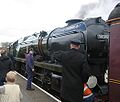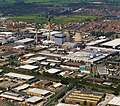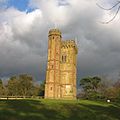The South East England Portal

South East England is one of the nine official regions of England in the United Kingdom at the first level of ITL for statistical purposes. It consists of the nine counties of Berkshire, Buckinghamshire, East Sussex, Hampshire, the Isle of Wight, Kent, Oxfordshire, Surrey and West Sussex. Cities and towns in the region include Aldershot, Ashford, Aylesbury, Basingstoke, Bracknell, Brighton and Hove, Canterbury, Chichester, Crawley, Eastbourne, Farnborough, Gosport, Guildford, Hastings, High Wycombe, Margate, Maidstone, Medway, Milton Keynes, Newport, Oxford, Portsmouth, Ramsgate, Reading, Slough, Southampton, Winchester, Woking and Worthing.
South East England is the third-largest region of England, with a land area of 19,072 square kilometres (7,364 sq mi), and is also the most populous with a total population of 9,379,833 in 2022. The region contains eight legally chartered cities: Brighton and Hove, Canterbury, Chichester, Milton Keynes, Oxford, Portsmouth, Southampton and Winchester. The region's close proximity to London has led to South East England becoming a prosperous economic hub with the largest economy of any region in the UK, after London. The region is home to Gatwick Airport, the UK's second-busiest airport, and Heathrow Airport (the UK's busiest airport) is located adjacent to the region's boundary with Greater London. The coastline along the English Channel provides numerous ferry crossings to mainland Europe.
The region is known for its countryside, which includes two national parks: the New Forest and the South Downs, as well as the North Downs, the Chiltern Hills and part of the Cotswolds. The River Thames flows through the region and its basin is known as the Thames Valley. It is also the location of a number of internationally known places of interest, such as HMS Victory in Portsmouth, Cliveden in Buckinghamshire, Thorpe Park and RHS Wisley in Surrey, Blenheim Palace in Oxfordshire, Windsor Castle in Berkshire, Leeds Castle, the White Cliffs of Dover and Canterbury Cathedral in Kent, Brighton Palace Pier, and Hammerwood Park in East Sussex, and Wakehurst Place in West Sussex. The region has many universities; the University of Oxford is the oldest in the English-speaking world, and ranked among the best in the world.
South East England is host to various sporting events, including the annual Henley Royal Regatta, Royal Ascot and The Derby, and sporting venues include Wentworth Golf Club and Brands Hatch. Some of the events of the 2012 Summer Olympics were held in the south east, including the rowing at Eton Dorney and part of the cycling road race in the Surrey Hills.
In medieval times, South East England included much of the Kingdom of Wessex, which was the precursor to the modern state of England. Winchester was the capital of England after unification of the various states, including the kingdoms of Kent, Sussex and Mercia. Winchester stopped being the administrative capital of England some time in the 13th century as its influence waned while the City of London dominated commerce. The last monarch to be crowned at Winchester was Richard II in 1377, although the last monarch to be crowned by the Bishop of Winchester was Queen Mary I in 1553. (Full article...)
Selected article
The Battle of Bonchurch took place in late July 1545 at Bonchurch on the Isle of Wight. No source gives the precise date, although 21 July is possible from the sequence of events. The battle was a part of the wider Italian War of 1542–1546, and took place during the French invasion of the Isle of Wight. Several landings were made, including at Bonchurch. Most accounts suggest that England won the battle, and the French advance across the island was halted.
The battle was between French regular soldiers, and local English militiamen. Although the French force that landed was considerably larger than the English force, it is thought that the number of French soldiers involved in this battle to be about 500, with the number of militiamen uncertain, with one source stating 300 and another 2,800. The English forces are believed to have been commanded by Captain Robert Fyssher, and the French by Le Seigneur de Tais.
The battle was one of several fought between English and French on the Isle of Wight. The majority of sources state that the English won this battle, although one suggests that the French were victorious. The battle was fought as part of the French attempt to cause enough damage to force English ships to leave their defensive positions and attack in less favourable conditions, which was something they failed to achieve and thus had to withdraw from the island Other French landings were made at Sandown, Bembridge, and St Helens. (Full article...)
Selected pictures
Selected biography

Timothy Henry Henman OBE (born 6 September 1974) is a British former professional tennis player. Henman played a serve-and-volley style of tennis. He was the first British man to reach the singles semifinals of Wimbledon since Roger Taylor in the 1970s. Henman reached six major semifinals and won 15 career ATP Tour titles (eleven in singles and four in doubles), including the 2003 Paris Masters. He also earned a 40–14 win-loss record with the Great Britain Davis Cup team.
Henman was the British No. 1 player in 1996 and again from 1999 to 2005, at which point he was overtaken by Andy Murray. He reached a career-high ranking of world No. 4 three different times between July 2002 and October 2004. He is one of the most successful British players of the Open Era, winning $11,635,542 prize money. In the 2004 New Year Honours, he was appointed an OBE.
Henman started playing tennis before the age of three, and began systematic training in the Slater Squad at eleven. After suffering a serious injury which affected him for the better part of two years, he began touring internationally as a junior and achieved some successes. He rose quickly up the ATP rankings, and by 1996 had reached the quarterfinals of Wimbledon. For most of his career, Henman was considered a grass court specialist, reaching four Wimbledon semifinals in the five years between 1998 and 2002. He also achieved considerable success on hard courts early in his career, with his first title on the top tier ATP tour won in Sydney with a straight sets win over Carlos Moya. He became comfortable on clay only later in his career, when in 2004 he reached the semifinals of the French. Henman retired from professional tennis in late 2007, but remains active on the ATP Champions Tour (a tour for former professional tennis players). (Full article...)
On This Day in South East England
29 September:
- 1920: Peter D. Mitchell was born in Mitcham, Surrey. He was awarded the 1978 Nobel Prize for Chemistry for his discovery of the chemiosmotic mechanism of ATP synthesis.
- 2007: Portsmouth F.C. beat Reading F.C. by seven goals to four at Fratton Park, setting a record for the highest scoring match in the Premier League.
Categories
Related portals
WikiProjects
Topics
Associated Wikimedia
The following Wikimedia Foundation sister projects provide more on this subject:
-
Commons
Free media repository -
Wikibooks
Free textbooks and manuals -
Wikidata
Free knowledge base -
Wikinews
Free-content news -
Wikiquote
Collection of quotations -
Wikisource
Free-content library -
Wikiversity
Free learning tools -
Wikivoyage
Free travel guide -
Wiktionary
Dictionary and thesaurus































































































































